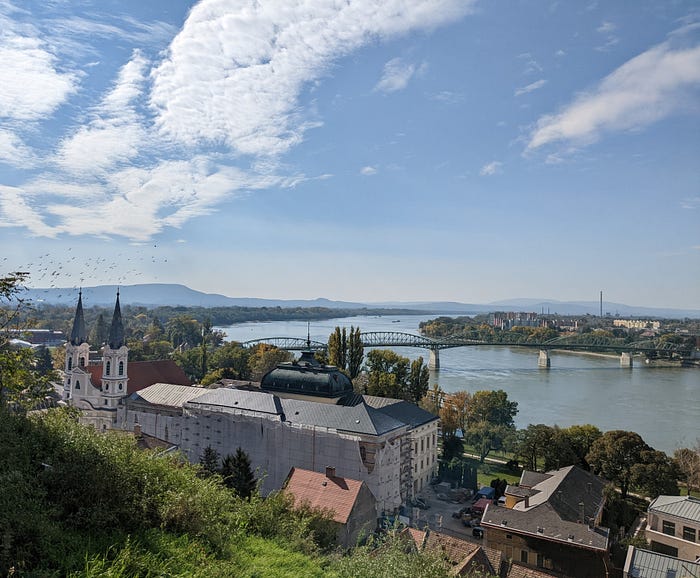Europe and the First Last Kilometer
By: Joel Epstein
In this installment, I look at what lessons Europe holds for the U.S. when it comes to urban transit, inter-city rail and the first last kilometer conundrum. For starters, to better serve passengers. old metro stations and trains don’t need to be dirty and gross.
Transit and transportation envy. That is what I feel when I travel in Europe. Even with war raging in Ukraine, the EU wows with its exceptional transportation infrastructure including some landmarks like the Estação São Bento in Porto and the M1 Metro, a UNESCO-protected metro line that runs along Andrássy Avenue in Budapest. The M1 Line is 126 years old making it the oldest on the European mainland.
While it is true that more travelers are taking advantage of low cost airlines to fly from places like Madrid to Budapest as I did earlier this month, much of Europe still boards trains and buses and trams that Americans can only dream about. That’s what you get when public infrastructure investment is in your DNA.
To make the contrast even starker, while I was away, the country’s paper of record published a depressing article about the pork barrel planning and ballooning cost of the ambitious California High Speed Rail project. When will the U.S. learn to do regional rail and urban transit right and within budget? Ditto the highways my girlfriend and I drove on (yes we drove as well on this trip) in Castilla y León and Galicia in northern Spain. Paved nirvana as a childhood friend would call them; smooth, safe roads boasting graceful bridges and signage that lets drivers know where they are heading and what they can expect up ahead. In short, the envy of U.S. drivers. Given the American addiction to cars, the crumbling state of U.S. roads and bridges, particularly in the Northeast, is enough to make one question our ability to get anything built or rebuilt in this polarized political environment. Yes, the President and Democratic Congress did pass a massive infrastructure bill though the jury is still out on what it will produce.
Walkability and bikeability are also front and center in Europe. The first last kilometer solutions that abound in cities like Budapest were on my mind when I walked into Nyugati pályaudvar station in Pest to catch a train to Esztergom, the onetime Hungarian capital (from the 10th until the mid-13th Century) in northern Hungary.
In both Budapest and Esztergom I marveled at the regional transportation, transit and micro mobility infrastructure. In Esztergom, arrivals are greeted outside of the small train station by a dock of bike share bikes that one can pedal around Esztergom and over the Danube River to Štúrovo, Slovakia.
The Esztergom/Štúrovo bike share program is a lot like Citibike, which you can ride in New York, and in Jersey City and Hoboken in that other country across the river.

I walked to Slovakia instead.

Back in Budapest, between the frequent trams, buses and metros, the Hungarian capital had me feeling transport and transit envy at nearly every turn. Meanwhile, here in the U.S. NIMBYism and fears of further gentrification have seemingly killed the waterfront BQX streetcar in Brooklyn and Queens and Los Angeles is still struggling to build a short downtown streetcar. And what about Congestion Pricing for New York City which is now not slated to arrive until the end of 2023, years behind schedule.
Europe’s urban and inter-city rail service is almost enough to convince me to learn Hungarian and claim citizenship by descent through the ancestor I am named after. I’m told that saying Köszönöm (thank you) repeatedly isn’t gonna cut it at the Consulate.
From its Soviet era workhorses to its state-of-the-art Central European electric buses and trams, Budapest makes the case for the all door boarding so rare on trains and buses in U.S. cities.

Yes, in New York we have off-board fare collection on SBS (Select Bus Service) buses, the City’s BRT (bus rapid transit) network, on a woefully inadequate, though growing, number of routes. The Q10 bus which I ride to the A train home when I fly into JFK is a case in point.
All Door Boarding
While the MTA’s OMNY card contactless fare payment system is a welcome leap forward for bus and subway riders as well as the transit agency, it is still not enough to help speed the buses jockeying for space with private cars and trucks on busy Lefferts Blvd as the Q10 crawls north from JFK through South Ozone Park, Richmond Hill and Kew Gardens. New York City needs both all door bus boarding and traffic enforcement targeting the ubiquitous double parked vehicles blocking City streets.
Can you say, “Delivery zones, more dedicated SBS only lanes and double parking and placard abuse enforcement?”
Caveat, in Budapest I saw plenty of riders getting onto buses and trams without validating their paper tickets. Surely not all of them are monthly pass or Budapest Card holders. Yes, for your visit, it’s probably worth getting a Budapest Card which gives you unlimited transit access as well as discounts at many cultural institutions.
All door boarding, trams, better first last kilometer infrastructure and better regional rail are all things we need now in many U.S. cities. On the positive side, I got back to New York on a beautiful Fall afternoon, breezed through Immigration and was on a spanking clean A train (they always seem to be Covid cleaning at Liberty and Lefferts) pretty expeditiously giving the single door boarding on the always busy Q10 Lefferts Blvd bus. The smell of cleaning product was almost enough to help me forget the fact that there’s no reason why the A train doesn’t make stops at the terminals at JFK like the Metro de Madrid at Spain’s busiest airport.
Tal vez, un día.
Yours in transit,
Joel
Joel Epstein is a New Yorker and an advocate for public transit, livable cities and public space.
#Europe #Budapest #Porto #Madrid #NewYork #Esztergom #MTA #FirstLastMile #FirstLastKilometer #FirstLastMile #alldoorboarding #transit #transport #rail #Citibike #bikeshare #chsr #highspeedrail
